It’s been a long time coming, this recipe. With the love of easy vegetarian flatbread pizzas around here at FITK, it’s a surprise it’s taken me this long to post my own flatbread recipe. If you’ve ever wanted to make your own for those quick and easy weeknight pizzas, this is the recipe you’ve been waiting for!
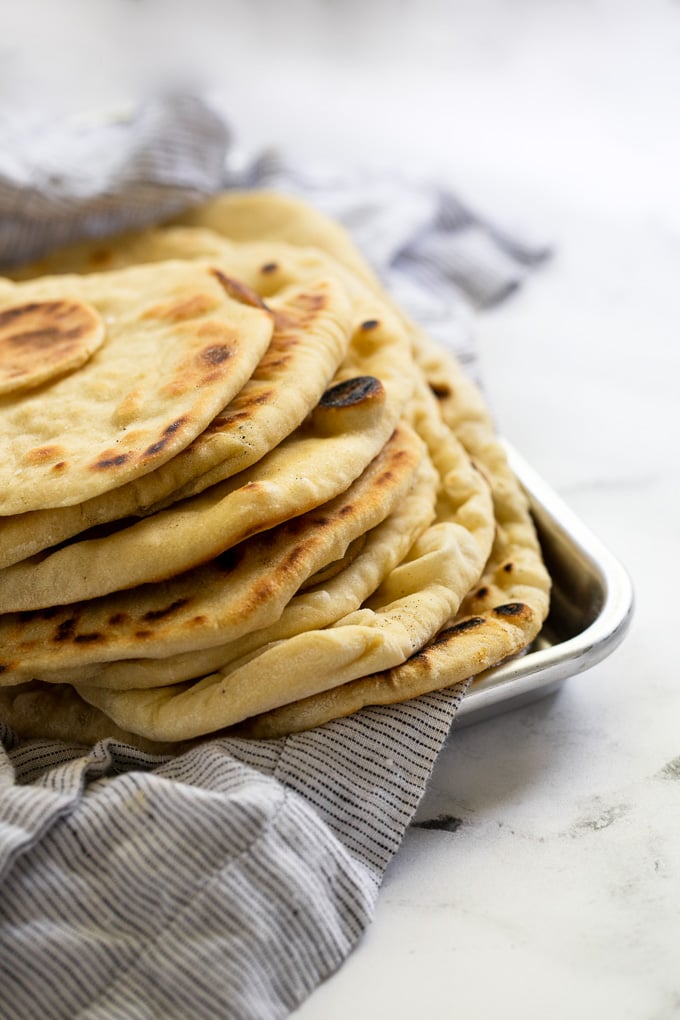
The dough is easy to make, and you don’t need to mess with sometimes finicky yeast, because this is a no-yeast recipe. It’s also naturally vegan and can be rolled thin into a crispy flatbread to top, or it makes the most beautiful naan-like flatbread, perfect for topping individual pizzas.
It’s not just a turn-into-pizza recipe either. Although, you know my heart (and stomach) do go straight to pizza.
This flatbread is perfect for dunking in lentil soup and sopping up each last bite of delicious broth. It makes the perfect dipping vehicle for green olive tapenade or whipped ricotta, and you can 100% enjoy it wrapped up and filled with delicious pita sandwich fixin’s.
What You Need to Make Homemade Flatbread
5 simple ingredients are all you need to make this easy homemade flatbread in less than 20 minutes (and let’s be honest, most of that is a little rest time!). I’m willing to bet you’ve got them already in your kitchen, too. Let’s see…
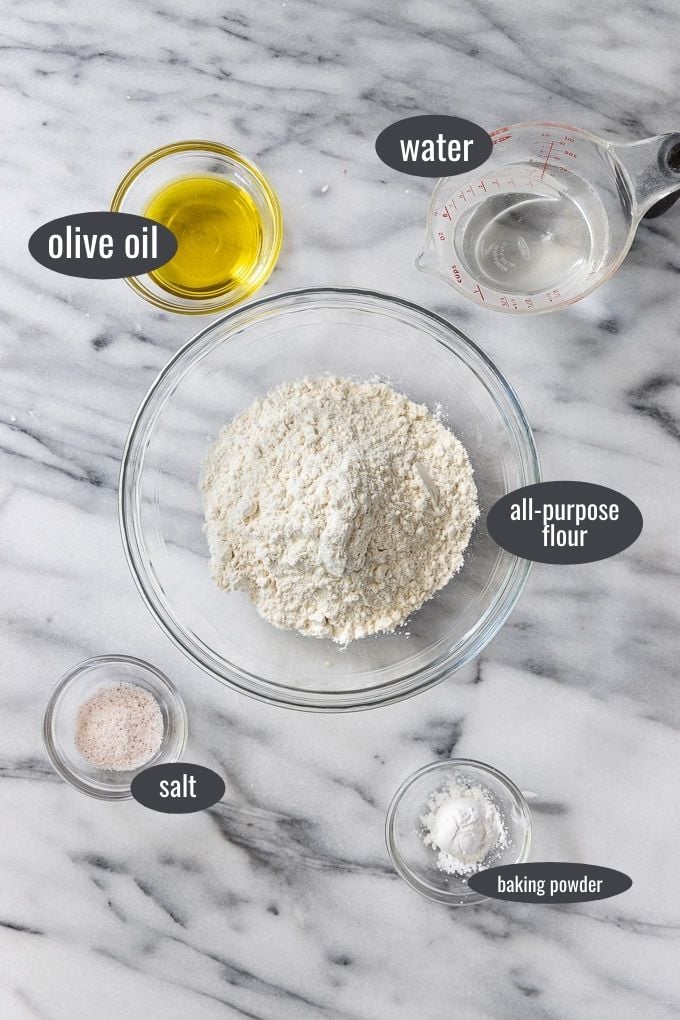
- All-Purpose Flour – there’s not much to say about the flour except for this: please weigh it out to measure. You will end up incorporating a little more flour throughout the kneading and rolling process, so it’s important to not get too much flour when you initially measure it out. If you can only use measuring cups, make sure you sift and scoop the flour in, not packing it down whatsoever.
- Baking Powder – helps to create the air bubbles in the flatbread and gives the bread its lift.
- Fine Sea Salt – if you are using regular table salt, you should halve the amount.
- Olive Oil
- Lukewarm Water
What is the Difference between Pizza and Flatbread Pizza?
Flatbread in general is thinner than typical pizza dough, and because this version is made without yeast, it comes together much more quickly. Flatbread pizza is simply flatbread with pizza toppings, so in the end, there isn’t much difference at all.
You can make flatbread pizza with crispier crust, or leave it a little thicker for a softer crust. It’s quick, simple, and an easy alternative to making homemade pizza dough.
Mixing Flatbread Dough
Making flatbread is really as simple as 1,2,3! Whether it’s a weeknight that needs some delicious carbs, Friday night pizza night, or a lazy weekend, this recipe will deliver.
First, start by mixing the dry ingredients. This gives you the perfect place to start, knowing the ingredients are fully combined. And don’t forget to weigh out the flour to measure it…
Then, gently stir in the wet ingredients. I like to use a spoon to start, until a shaggy mixture forms (photos 3-4). Then, I go all-in with my (clean!) hands and continue to combine the dough. At first, it may seem too dry, like all the clumps are not coming together. Don’t add any more liquid just yet! Keep kneading the dough and it should all come together and result in a soft, supple dough.
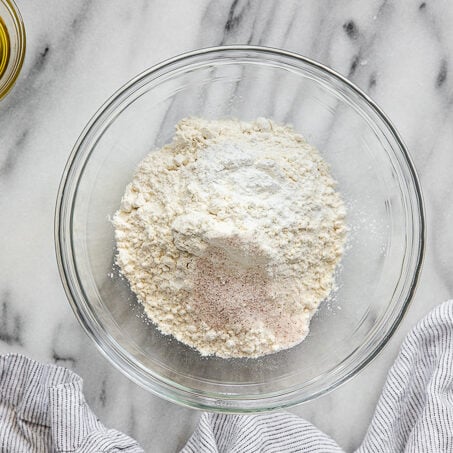
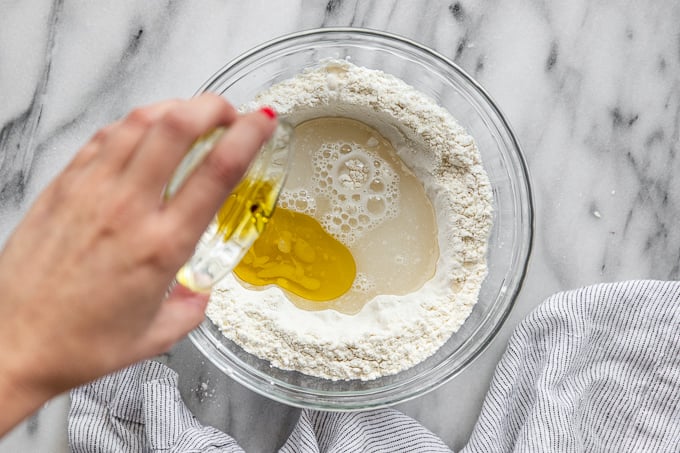
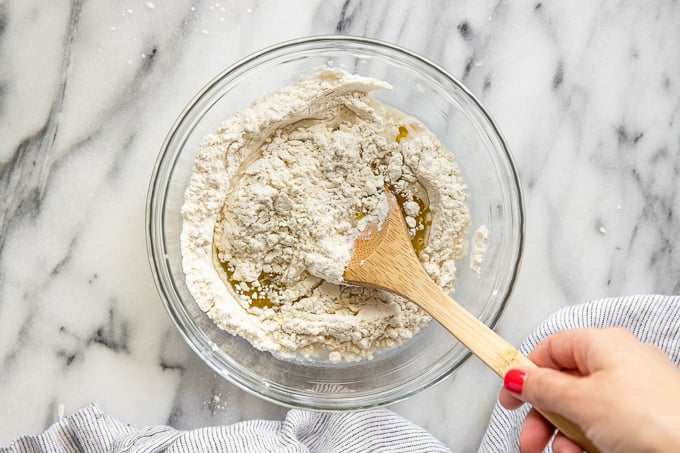
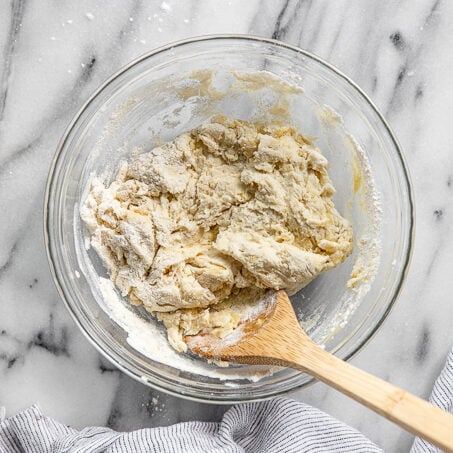
At this point, you’ll likely need to start sprinkling flour on your surface and your hands to continue kneading the dough so that it doesn’t stick. Move quickly while kneading to prevent it from sticking, too.
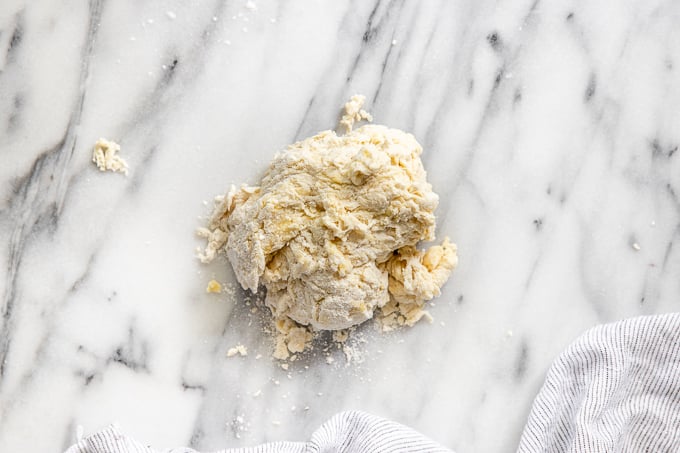
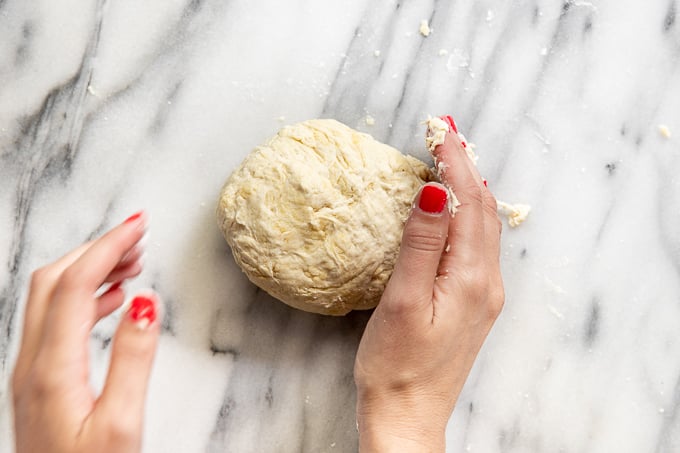
Once the dough is soft, supple, and tacky but not stubbornly sticky, place it back in the bowl to rest for 10-15 minutes. I recommend covering it, too, so that it doesn’t dry out at this point.
If you’re making naan pizzas with flatbread, now would be the perfect time to prep your topping ingredients.
Rolling Out Homemade Flatbread
After the dough has rested, divide the dough in two. Please see the notes below for serving size, as you can adjust this dough depending on the texture of the crust you prefer, and how thin you’d like the flatbread. For right now, we’re walking through 2 servings, that will result in flatbread in similar texture and size to store-bought naan.
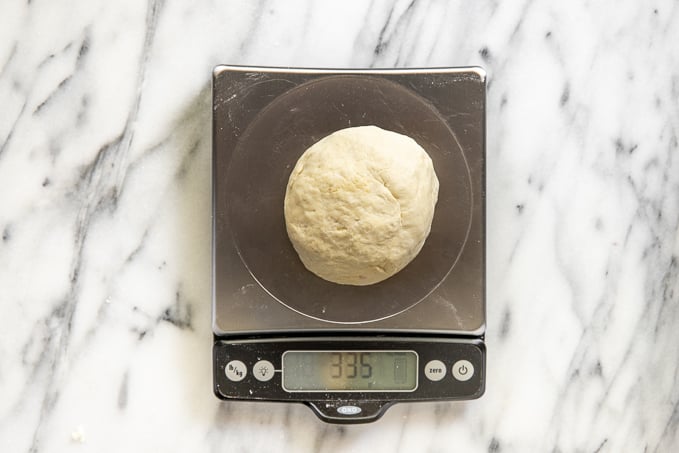
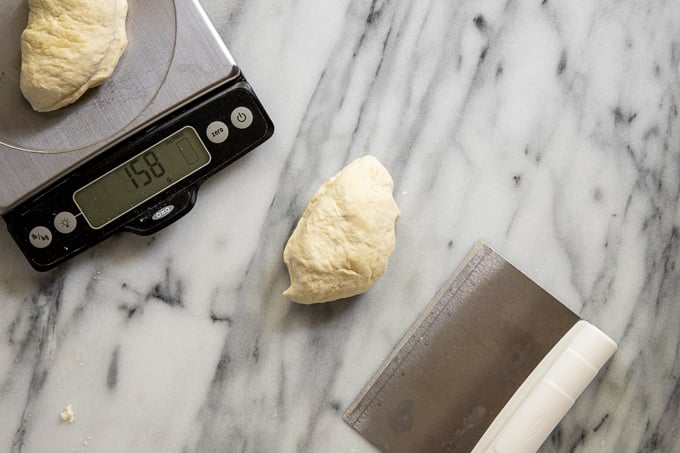
I recommend using a scale to weigh the dough and see what each piece should weigh. This will give you the most evenly sized flatbreads, however, you can totally eyeball it too.
Once you have the section of dough, sprinkle additional flour on your work surface so the dough doesn’t stick while rolling it out. Use a rolling pin – big, small, or a wine bottle – to roll the dough into an oval that’s approximately 7 inches by 9 inches, and about 1/8 inch thick.
Do your best to roll the dough as evenly as possible, so it is the same thickness all around.
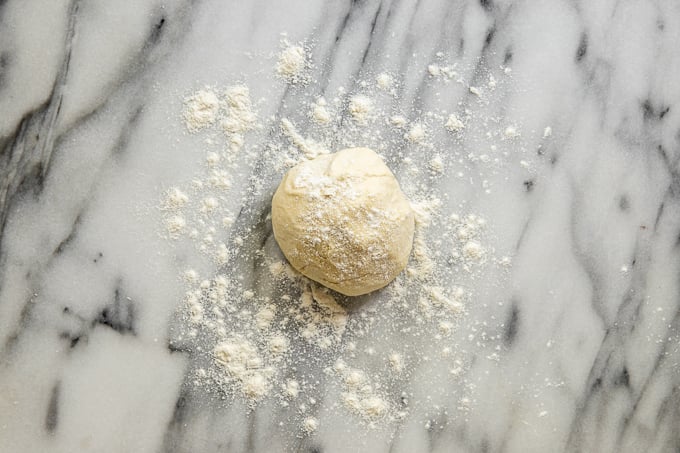
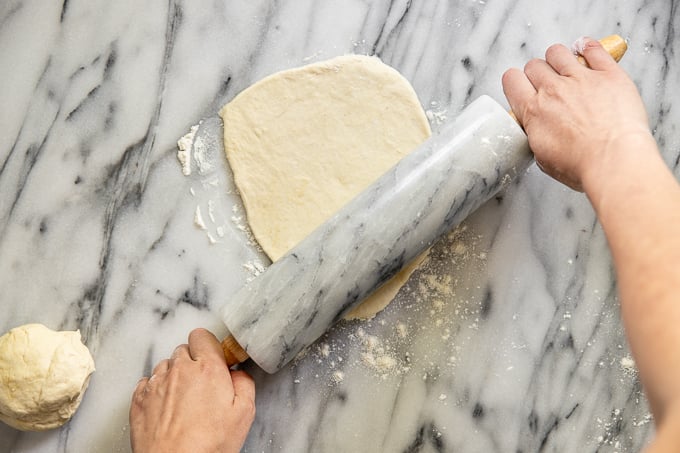
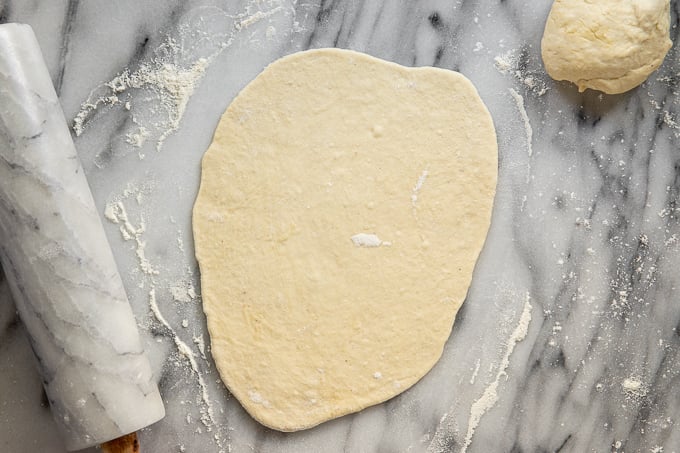
How to Cook the Flatbread
There are two options when it comes to cooking this flatbread: on the stovetop, or par-baking it before adding pizza toppings.
To mimic using store-bought naan and turning it into a flatbread pizza, I highly recommend going the stovetop route. I would also recommend this method if using flatbread to serve alongside curries, soups, or otherwise. It provides a soft, fluffy flatbread texture with beautiful bubbles and slightly crispy edges.
Get a large cast-iron skillet hot, preparing it over high heat to do so. If your cast iron isn’t seasoned well, you may want to lightly – very lightly – oil it, using only a half teaspoon or less of olive oil. The flatbreads cook best when there isn’t much oil or none at all.
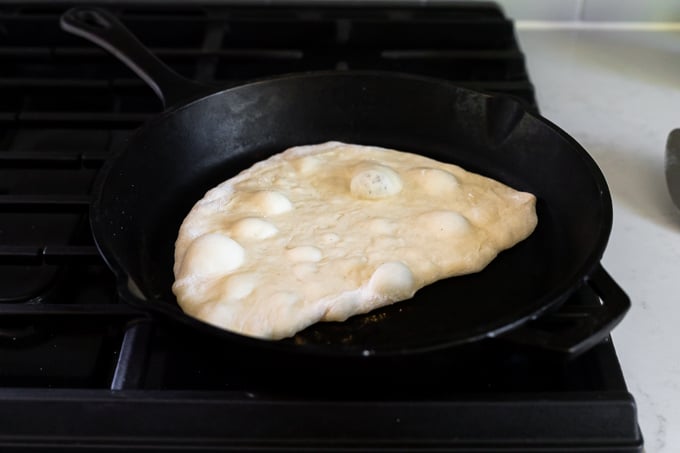
They will get crispier the hotter they cook, which also increases the risk of tearing if folded. If you plan on using the flatbreads to make pizza, this isn’t a problem. But if you want to wrap the flatbreads into pitas, you may want to reduce the heat when cooking in order to keep them completely soft and pliable.
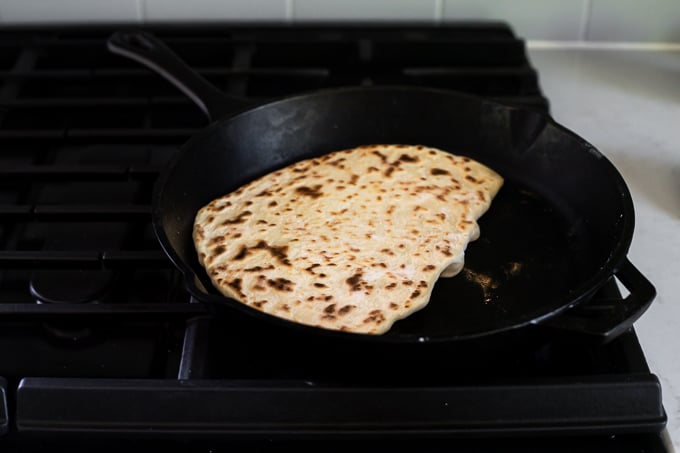
Cook the dough on high for a couple of minutes until starting to turn golden brown. You will also notice bubbles developing on top as the first side cooks. Flip the flatbread and cook for an additional 2 minutes or so, depending on how hot your pan is, removing once golden brown.
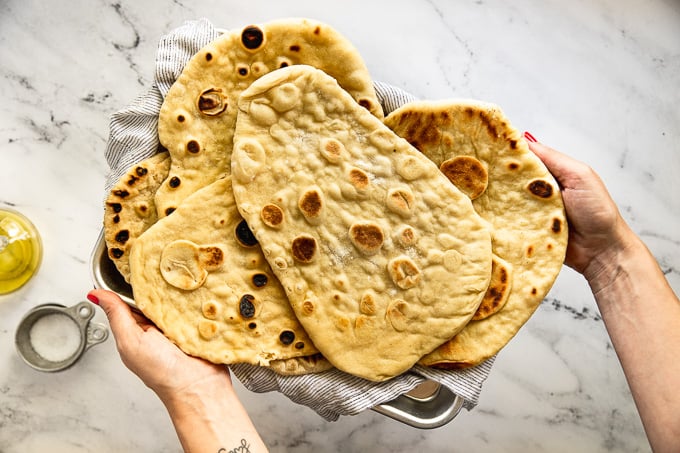
Making Flatbread Pizza
Once the flatbread has cooked on the stovetop, it’s ready to be turned into an easy naan flatbread pizza! Be sure to see notes about par-baking the crust to make it into a pizza without the stovetop method, however, I prefer cooking it on the stovetop and then baking it like a pizza.
It allows the crust to get crispier and develops those lovely air pockets. It’s also the most comparable to my many flatbread recipes that start with store-bought naan.
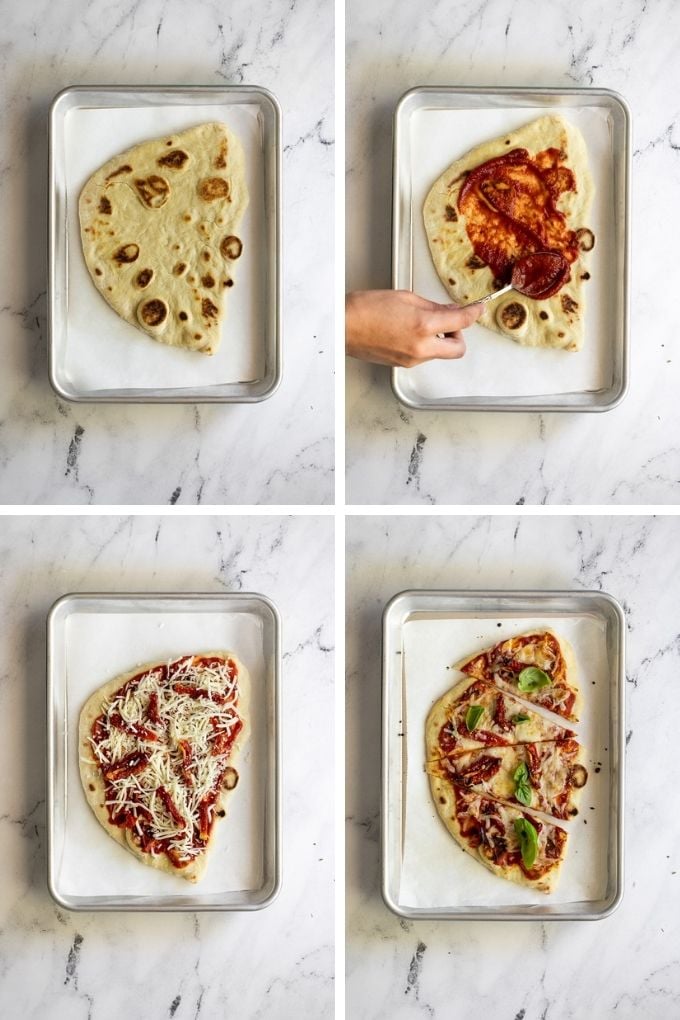
From this point, you simply need to top the flatbread with your pizza toppings, then bake until the cheese is melted and the crust is golden brown and crispy, as desired.
You can easily prepare the flatbreads ahead of time, too, which means a quick dinner is in your future!
To par-bake the crust, then make it into a pizza, you can use the entire dough recipe or divide it into 2-4 pieces, depending on how crispy you’d like the crust. The more sections you divide the dough in, and the thinner you roll them, the crispier they will be.
Once you’ve baked the rolled dough for about 8 minutes until set, you can add your sauce and toppings, then continue to bake until the edges are golden brown. Again, the crispiness will depend on how thin it is rolled.
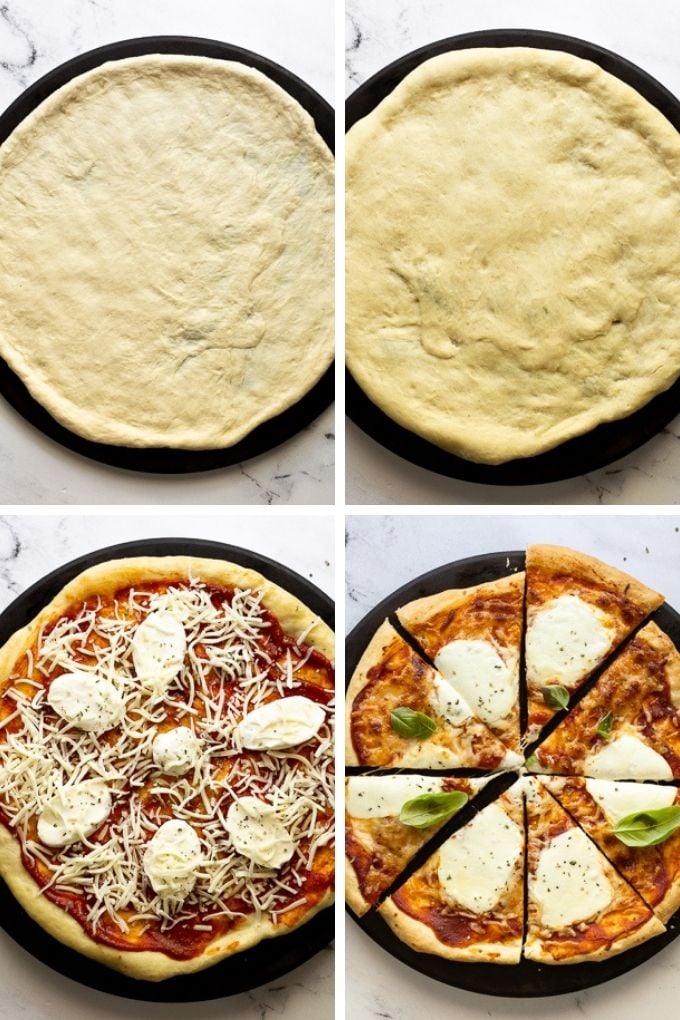
Recipes to Use with Flatbread
I’ve already mentioned some of my favorite ways to use flatbreads, and to recap, it’s turning them into easy weeknight pizzas. I also love serving them with hearty soups that I can dip them into, like Broccoli Butternut Squash Soup or Homemade Chili.
They’re an excellent option to serve alongside dips like Jammy Roasted Red Pepper and Tomato Spread, Lazy Girl Tzatziki, or Creamy Artichoke, Kale, and Leek Dip.
But now about those pizzas. I have quite a few homemade flatbread pizza recipes on FITK already that can be made using homemade or store-bought flatbreads.
- Mediterranean Flatbread
- Bruschetta and Burrata Flatbread
- Artichoke and Arugula Flatbread
- Grilled Peach and Pesto Flatbread
- Grilled Corn, Burrata, and Pesto Flatbread
- Citrus Pesto Flatbread Pizza
- Zucchini, Corn, and Brie Flatbread
- Margherita Flatbread Pizza
- Rosemary Potato Breakfast Pizza
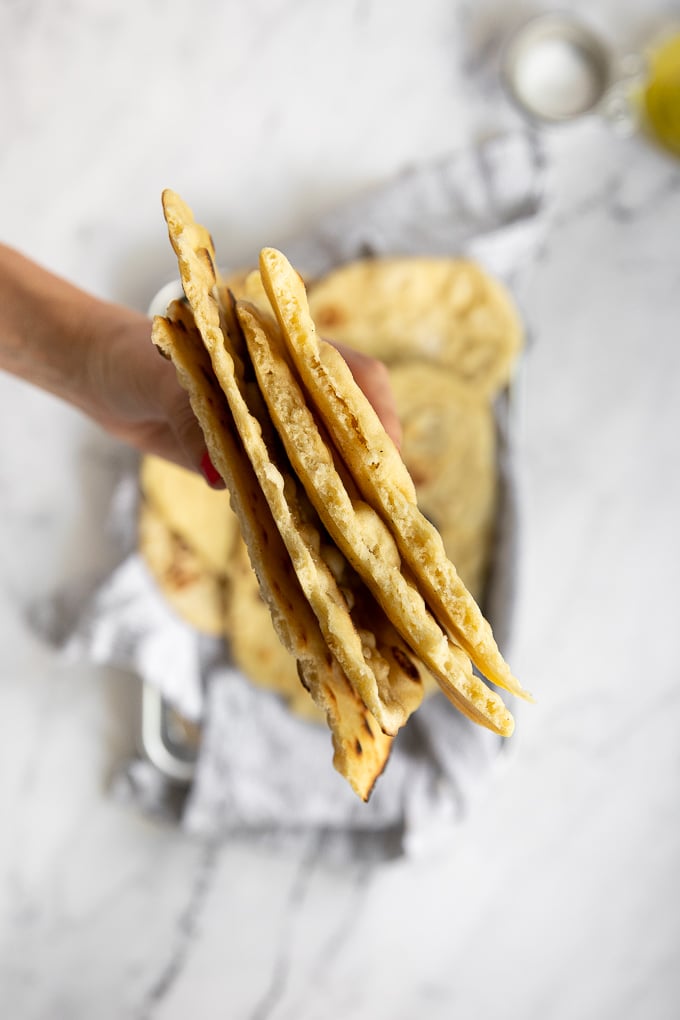
Storage and Freezing Tips
Store leftover flatbreads in an airtight container; they are best eaten within 1-2 days.
Freeze the prepared dough by wrapping it tightly with plastic wrap or freezer paper. When you’re ready to use, thaw in the fridge or at room temperature. To freeze cooked flatbreads, wrap them individually and place them in the freezer. When you’re ready to use, thaw at room temperature.
Did you make this recipe? Please leave a star rating and review in the form below. I appreciate your feedback, and it helps others, too!
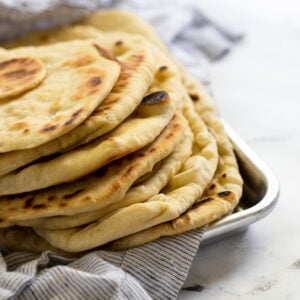
Get the Recipe How to Make Homemade Flatbread
Ingredients
- 1 ½ cups (182g) all-purpose flour, additional for rolling
- 1 ½ tsp baking powder
- ¾ tsp fine sea salt, see note for table salt
- 2 Tablespoon olive oil
- ½ cup lukewarm water
- ½ tsp olive oil, for cooking, optional
- Corn meal, optional, for full pizza
Equipment
Instructions
- In a medium-sized mixing bowl, combine the dry ingredients.1 ½ cups (182g) all-purpose flour, 1 ½ tsp baking powder, ¾ tsp fine sea salt
- Add in the wet ingredients and stir with a spatula or your hands until a shaggy mess forms, then begin using your hands to knead the dough together. It may seem dry, but keep kneading and the pieces will all come together. If it is too sticky, add sprinkles of flour as needed. Knead for two minutes until the dough is soft and supple, then cover and let rest for 15 minutes.2 Tablespoon olive oil, ½ cup lukewarm water
Stovetop Method
- Divide the dough into two equal portions and flour your work surface. Use a rolling pin or your hands to form ovals that are approximately 7×9 inches and ⅛ inch thick. The dough will puff up when it cooks, so you want it to be thin, and as evenly pressed as possible. You can also divide the dough into 4 smaller flatbreads.
- Heat a large cast-iron skillet over high heat on the stove, you want the skillet hot and a little pan-smoke is ok. I prefer to cook the flatbreads dry, but you can brush 1/2 teaspoon of oil on the surface if you prefer.½ tsp olive oil, for cooking
- Once the skillet is hot, carefully place one flatbread on its surface. Let the flatbread cook for about 2-3 minutes, until bubbles have formed on the surface and the downside is starting to turn golden brown. Reduce the heat slightly if the pan begins to smoke too much from any excess flour. Flip the flatbread and cook for an additional 2 minutes or so, until golden brown. Repeat with the remaining flatbread.
Par-Bake Method
- If you prefer to par-bake the flatbread, preheat the oven to 425°F. Place the formed flatbread dough on a parchment lined baking sheet or pizza stone and bake for about 8 minutes.
- Remove from the oven and place your toppings on each flatbread, then bake for an additional 10-12 minutes until the edges are golden brown and the cheese is melted.
Notes
- Table Salt: if substituting table salt for fine sea salt, use 1/2 teaspoon.
- Freezing the Dough: Wrap rested dough in plastic wrap or freezer paper. When ready to use, thaw in the fridge or on the countertop until pliable. Continue as directed to bake.
- 4 Flatbread Pizzas: Divide the dough into 4 portions and make 4 very thin flatbread pizzas that are approximately 8 inches wide. This will result in a very crisp crust. You can use the stovetop or par-bake method for cooking, although because they are thinner I find par-baking is preferred.
- 1 Full Pizza: You can turn the dough into a full-sized pizza, too. Preheat the oven to 425°F. Stretch the dough into approximately a 12-inch circle and place on a cornmeal-dusted baking sheet or pizza stone (this keeps it from sticking, but isn’t essential depending on your pan). Par-bake the crust for about 8 minutes. Brush the crust with olive oil and add the desired toppings and continue baking for 13-16 additional minutes, until the crust is golden brown and cheese is melted.
- 6/2022 update: per feedback and further testing, reduced fine sea salt from 1 1/4 teaspoon to 3/4 teaspoon and added clarified how salt should be substituted in this recipe.
But wait!
This recipe is part of our collection of easy flatbread pizza recipes. Check it out!

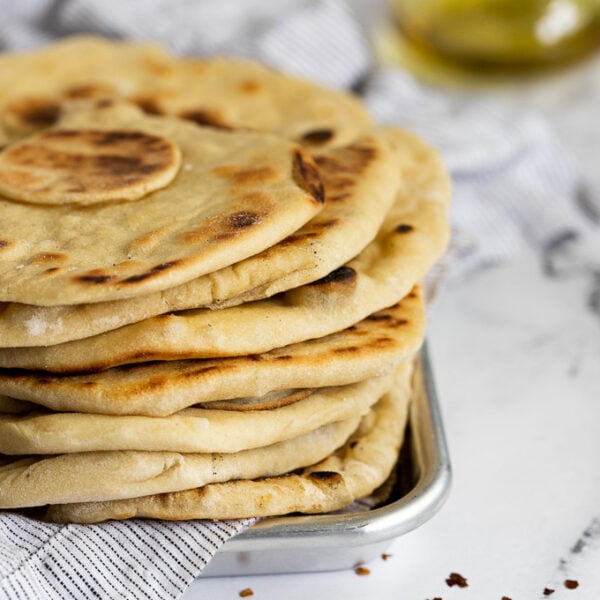
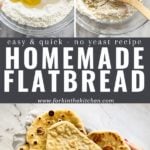



I love flat bread and am so excited to have this recipe and be able to make it for myself and husband in the future! Thank you so much for the recipe!
Yes! There are so many ways to enjoy it, too. I hope you enjoy!
The directions were very clear and easy to follow, which, as someone who doesn’t bake often, I appreciate. That being said, the bread is wayyy too salty. I had to throw out the batch because I couldn’t take the salt content. I’m not an experienced baker so I make sure to follow directions exactly as written. I know I didn’t use the wrong measuring spoons because I even checked after tasting the bread. I think if the salt was adjusted this would be a top notch recipe!
Hi Anastasia – could you tell me which specific kind of salt you used?
I have made this recipe over and over! So easy, the only flatbread I have ever made that came out so flexible and yummy. My only problem is that I had a “non-stick” pan, and had burnt flour all over it. When I couldn’t get get it clean, I finally replaced it. SAME problem! Is this something that I may be doing wrong? Does it really require cast iron? I will buy one just for these, as I have had no other bread since I started making them, lol.
I’ve done without oil, then with, lowered the heat,
Nothing made it better.
Hi Andrea – I’m so glad you’re loving the flatbreads but I am SO sorry to hear about your pan! I wouldn’t recommend using non-stick since the temperature does need to be high, and since you already tried with oil and lowering the heat (which is what I would’ve recommended first for using non-stick…lower heat, longer time) it seems that a different pan might be needed. Do you have a stainless steel or aluminum pan? These would be the other best options instead of cast iron.
Either way, depending on how much flour is on the flatbreads you likely will have a little that gets cooked on the pan; I haven’t had issue cleaning it out of the cast iron though (baking soda (any pan) or coarse sea salt (on cast iron) are great in this case).
Let me know if you have any other questions!
Worked. I increased the serving size to 8, and then decided into small mandarin orange size…
Made 12 small Flatbread for soup dinner.
Good recipe!
Paul
Awesome! Thanks so much for your review, Paul, I’m glad you enjoyed them!